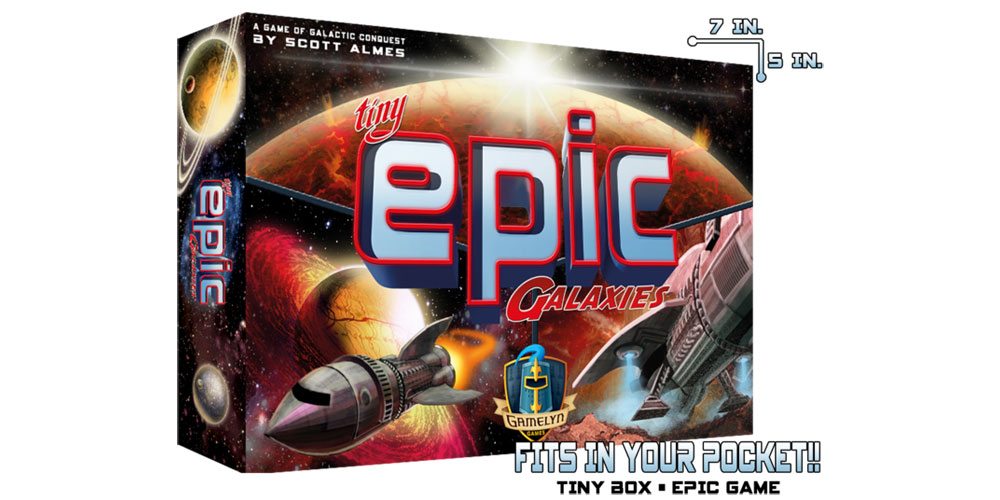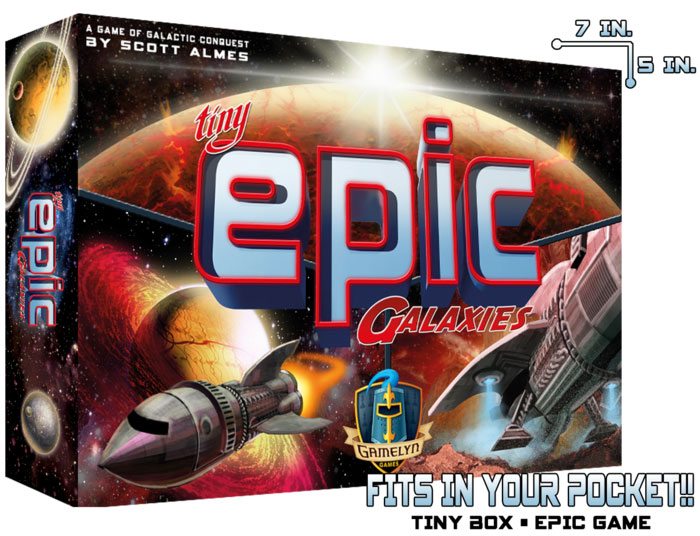Last year Gamelyn Games took Kickstarter by storm with its first “Tiny Epic” game designed by Scott Almes, Tiny Epic Kingdoms. This pocket-sized, fantasy-themed 4X game raised $286k on a $15k goal–fans loved all the stretch goals, and by the end of the campaign the $16 was an incredible value. Lightning struck again in July with Tiny Epic Defenders, a cooperative game (also set in the fantasy universe). Today, Gamelyn Games and Almes shoot for the stars with Tiny Epic Galaxies, a space-based empire-building game just launched on Kickstarter.
New to Kickstarter? Read our crowdfunding primer here.
At a glance: Tiny Epic Galaxies is a game about galactic conquest for 2 to 4 players, ages 13 and up, and takes about 30 minutes to play. The base pledge for a copy of the game is $16, or you can up that to $24 for the deluxe version, which includes a mini expansion. There are also pledge levels for multiple copies, and some high-end pledge levels to name a planet in the game.
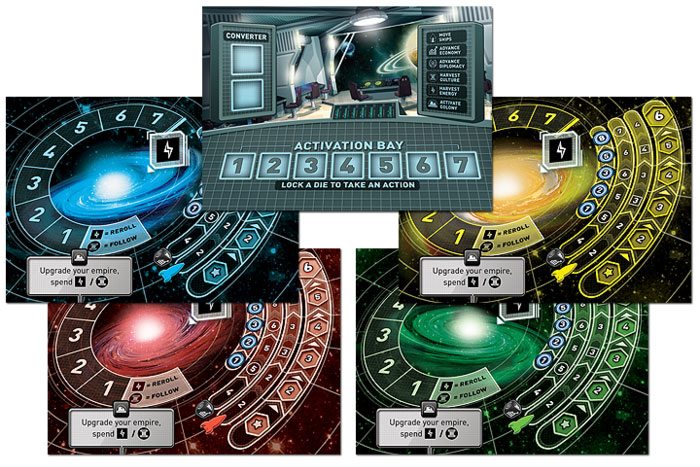
Components:
- 7 custom screen-printed dice
- 16 rocket ships (4 in each color)
- 4 circle tokens (1 in each color)
- 4 hex tokens (1 in each color)
- 4 cubes (1 in each color)
- 24 cards (12 energy planets, 12 culture planets)
- 5 oversized cards (1 control card, 4 player galaxies)
The exact component list is somewhat subject to change if the project hits various stretch goals–the highest one, at $100k, is to replace the screenprinted dice with engraved dice, which would be much more durable.
I received a prototype version to play, so the photos you’ll see throughout my post are the preliminary stand-in artwork. You can compare these to the more finalized art and design, taken from the Kickstarter page.
How to play
There’s a print-and-play available for free if you want to try it out; the rules are also available here as a PDF.
The goal of the game is to score the most points through colonizing planets and upgrading your galaxy.
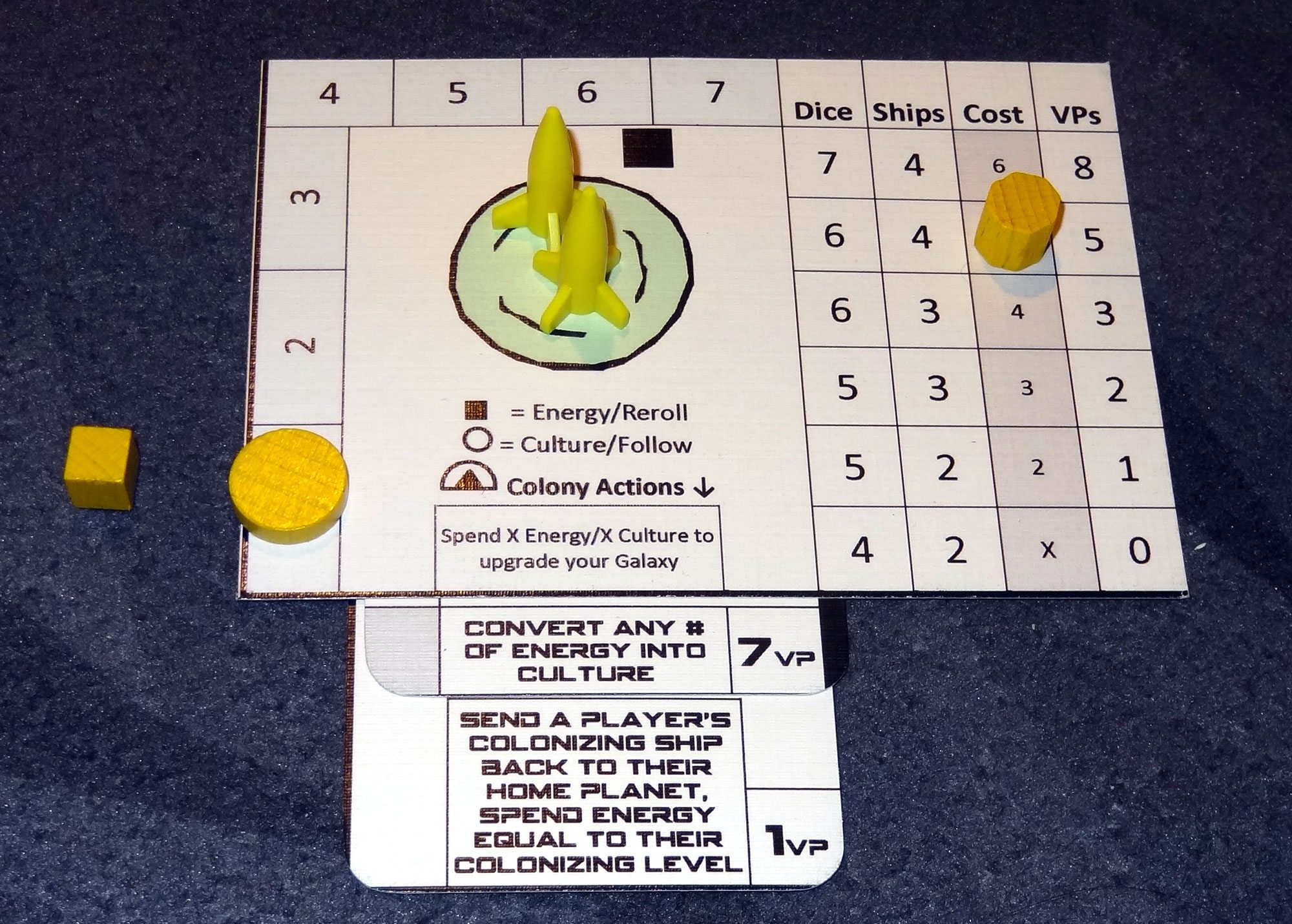
Each player starts with a player card, two ships on their home planet, a Level 1 galaxy (marked with the hex token), and a few resources: culture and energy. Generally, energy is spent to re-roll dice on your turn, and culture is spent to copy another player’s action when it’s not your turn. Upgrading your galaxy will give you more ships, let you roll more dice, and give you more points.

You also shuffle all of the planet cards, and deal some out in the center–two more than the number of players. Each planet has an icon in the top corner that shows whether it produces energy or culture. There’s also a colonization track, which could be either diplomatic or economic, and a unique ability that planet gives you. Finally, there’s a point value if you manage to colonize the planet.
On your turn, you roll dice–at the beginning, you get 4 dice. You get one re-roll, which can be used to re-roll any number of the dice that you haven’t activated yet. You may also spend energy for additional re-rolls.

Each die has the following six faces: Move Ships, Harvest Energy, Harvest Culture, Advance Diplomacy, Advance Economy, Activate Colony.
Move Ships: move one of your ships to a different planet. If you land on the surface of the planet, you immediately trigger that planet’s ability. If you land on the colony track, you can try to colonize the planet and take it for yourself.
Harvest Energy/Culture: You gain one unit for each ship that is on the matching planet (whether it’s on the surface or the colonization track). Everyone’s home planet produces energy.
Advance Diplomacy/Economy: Move a ship up one space on the matching colonization track. If you reach the end of the track, all the ships on the planet go home and you take the planet, tucking it under your galaxy card.
Activate Colony: You may use the colony ability of any planet you have. Your home planet’s colony ability is to upgrade your galaxy (by spending either energy or culture as shown on the card).
Each time you activate a die, after you take the action, each other player gets a chance to spend culture to follow that action. So if you used a Move Ships die, another player could spend 1 culture to move a ship. If you used Activate Colony, another player could activate one of her own colonies by spending a culture.

There’s one other option: once per turn, you may use the “converter”: put any two dice into the converter, and then turn another unused die to any face you choose. Other players may not copy the effects of the dice you put into the converter.
When one player reaches or exceeds 21 points, all other players get one more turn, and then the game ends. The player with the highest score wins; ties are broken by number of planets colonized, then the level of planets colonized, then number of resources remaining.
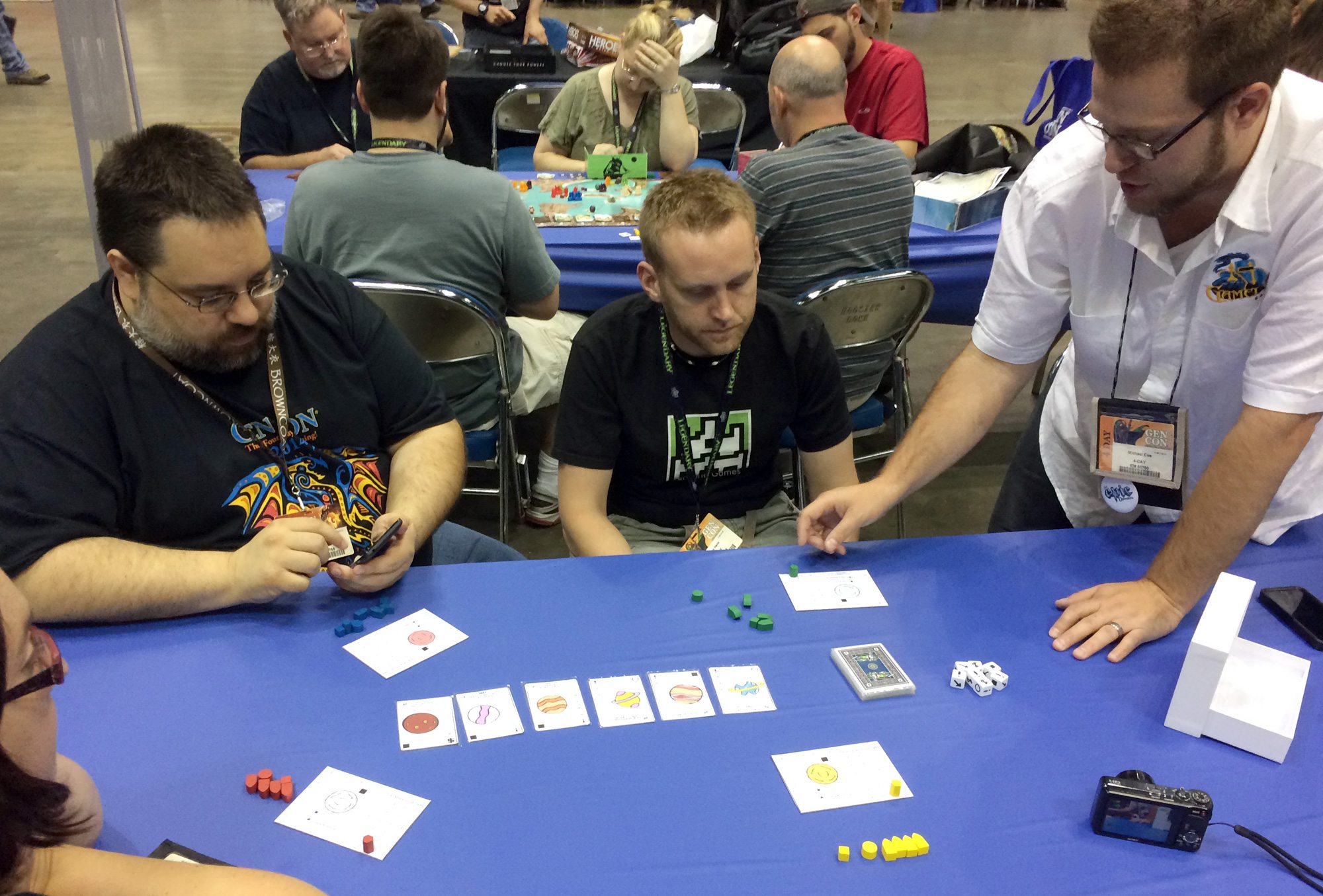
The Verdict
I first got the chance to try Tiny Epic Galaxies at Gen Con last year; Michael Coe of Gamelyn Games had a prototype with him and we really enjoyed it. At the time, we were still waiting on the delivery of Tiny Epic Kingdoms and the Kickstarter for Tiny Epic Defenders had just ended, but it was clear that designer Scott Almes wasn’t out of ideas yet. Having played both of the other games, I was curious to see what else he had up his sleeves, and I wasn’t disappointed.
I had to wait until recently to play again, though, when Coe sent me a prototype to review. Despite the unfinished artwork on the prototype, I’ve really enjoyed playing it. I like that it’s not just a re-skinned Tiny Epic Kingdoms, but actually has its own new mechanics.
The die-rolling certainly introduces more of an element of luck than in Tiny Epic Kingdoms, which had players choosing actions from a set list. However, the ability to spend energy to re-roll dice can give you more options, and as you colonize planets you’ll add additional colony abilities that can get you out of a tight spot. Plus, I like rolling dice.
I also like the planet abilities, and the trade-off between colonizing a planet and landing on the planet for the one-time ability. Some abilities are powerful enough that everyone wants to use them right away, but if you colonize it and take it for yourself, eventually you will be the only one who has access to that ability–plus it’s worth points. There’s also a mix of planets that help you, planets that harm your opponents, and even planets that help you a lot and help your opponents a little. Planets with shorter colonization tracks are worth fewer points and generally have less powerful abilities, so you’ll have to make wise decisions about which ones to colonize, too. You can go for lots of small, quick-to-colonize planets, or a few big scores.
Upgrading your galaxy is important, of course: not only is it worth points, but getting extra ships and dice is crucial. If you’re still stuck with 4 dice and 2 ships, you’re at a distinct disadvantage against the player with 7 dice and 4 ships.
The culture-spending action is terrific. Since any player may spend culture to follow the active player’s action, it means that (as long as you have culture to spend) you’re always interested in what’s going on, even when it’s not your turn. It also means that when it’s your turn, you’ll sometimes need to be careful what you let other players do. The one downside is that if you spend all your culture and you don’t have a good way to get more–as luck would have it, sometimes all the available planets only generate energy–then it can become a game in which you’re just waiting for your own turn.
I think there aren’t quite as many different avenues for victory in Tiny Epic Galaxies as there were in Tiny Epic Kingdoms, partly because the only ways to get points are through colonizing planets and upgrading your galaxy. However, there are still a lot of different ways to go about that: using Move Ships to jump around and activate planet abilities, using colony actions to take advantage of powers that you’ve built up, and spending culture judiciously to follow another player’s action when it benefits you the most.
And, while this isn’t really a comment on the gameplay, it must be said that I’m always thrilled to see more publishers putting big games in small boxes. I’m tired of the giant box wars–fighting for shelf space, making your game look bigger than it actually is. It reminds me of the state of software packaging in the early ’90s: everyone knows it’s just a box of air with a jewel case inside, but you have to compete for shelf space. I’m hoping the Tiny Epic series of games will show publishers and retailers and consumers that a small box game can still provide a satisfying experience.
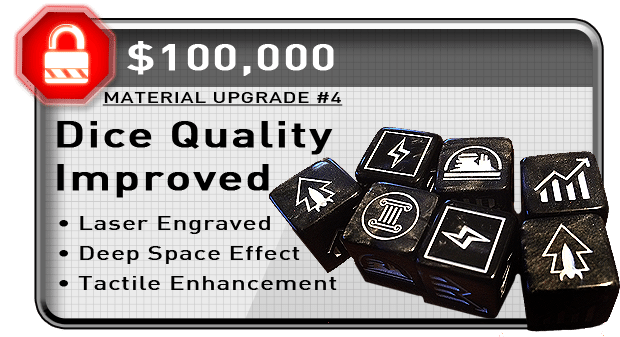
Overall, I think Scott Almes and Gamelyn Games have another hit on their hands. Tiny Epic Galaxies is an excellent game that works well with two, three, or four players. It plays fairly quickly but still fits in plenty of meaningful decisions, and is small enough that you can easily take it with you–along with the other titles in the Tiny Epic line. And you can be pretty sure that the project will hit a lot of its stretch goals, making both the $16 level and the $24 level a good value.
For more information and to back the project, visit the Tiny Epic Galaxies Kickstarter page.
